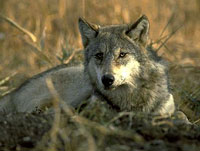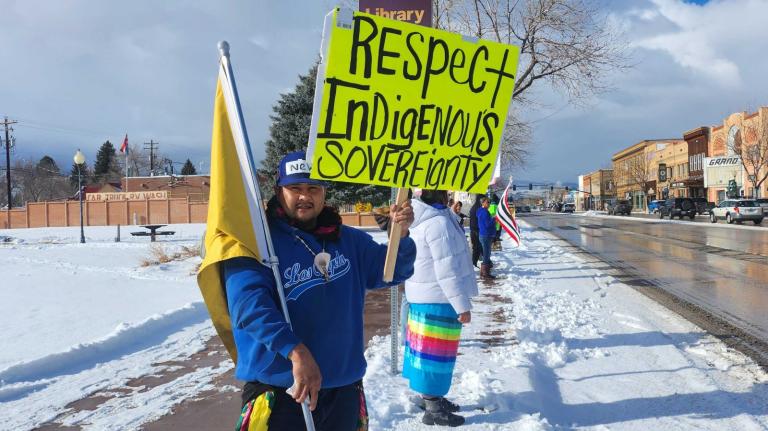Two years after the first 11 Mexican gray wolves were released to much fanfare in the Apache National Forest of southeastern Arizona, and a year after an additional 22 wolves were freed in 1998, only seven remain in the wild.
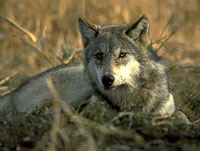
A lone wolf.
Photo: J. & K. Hollingsworth, U.S. Fish and Wildlife Service.
The problems the wolves face today are the same as those that originally drove them to the brink of extinction: Livestock interests have usurped the public domain and marshaled the forces of government to transform the dynamic yet dry Western landscape into one in which a slow-moving, water-loving exotic animal could survive.
Poisoning and trapping every wolf was part of the same development mentality that dictated the damming and diversion of every stream. But in an era when dams are being removed to rehabilitate aquatic ecosystems, federal agencies still regard cattle as an immutable aspect of the landscape, which wolves will have to navigate around like salmon darting between the fast blades of hydroelectric turbines.
Consider the case of the Gavilan Pack — an alpha pair, a yearling, and five pups released near a steep-walled canyon lined with ponderosa pine and Gambel oak. This area was so severely grazed that last year a U.S. Forest Service that had long cozied up to the livestock industry ordered cattle removed to allow it to recover. But the local rancher, Carlyle Cathcart, claiming mythical private property rights to the national forest, refused to move his cattle, and the district ranger backed down, unwilling to enforce his own order.
Government biologists, believing the cattle had been removed, released the Gavilan Pack close by. Not surprisingly, the wolves quickly learned to prey on cattle in an area with so little grass that scarcely a rabbit, much less deer or elk, was available for them to eat.
The biologists enticed the wolves away with road-kill food. But there was no safe place available. The pack crossed over the New Mexico line into the Gila National Forest, part of the Mexican wolf’s designated recovery area, and there encountered a dead cow, fed on that, and shortly afterwards killed two more cattle.
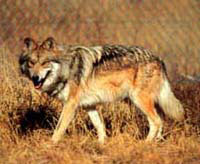
My, what big cows you have.
Photo: Jim Clark, U.S. Fish and Wildlife Service.
As a result, the government recaptured the Gavilan Pack and removed it from the wild, save for an adolescent male who escaped into the wilds north of the Gila Wilderness, and a pup who is presumed dead.
More recently, the Mule Pack was also recaptured after feeding on the carcasses of a cow and a horse. Federal biologists feared these four wolves would become habituated to livestock, and removed them even though no domestic animals had been attacked. In the course of that trapping, the alpha female’s leg was injured and had to be amputated.
Now the U.S. Fish and Wildlife Service is considering releasing members of these and another recaptured pack directly into the safety of the Gila Wilderness, which along with surrounding national forest lands comprises 700,000-plus acres — over 1,000 square miles — without cattle. Here is a vast and wild landscape in which wolves can roam safely, preying on elk, deer, and javelina, with no threat of drive-by shootings, and with no reason for them to be trapped and relocated.
One might think ranchers would welcome wolves being put where their cattle don’t roam, but in fact the prospect is eliciting even greater opposition than the original release in the Apache National Forest.
In late February, at a rally in Catron County, N.M., anti-wolf organizer J. Zane Walley called the reintroduction of wolves “virtual cultural genocide,” while a U.S. Senate candidate, State Sen. Bill Davis (R), told the assembly that their ancestors had owned the Gila before the federal government took it from them upon statehood. In fact, the Gila Forest Reserve (later renamed “National Forest”) was designated in 1899, 13 years before New Mexico became a state, while a few refugee Apaches were still hiding in the mountains. (Ask their descendants what “cultural genocide” means!)
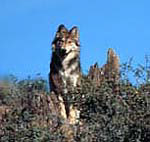
Hungry like the wolf.
Photo: Jim Clark, U.S. Fish and Wildlife Service.
But it was the owner of the last cattle killed by the Gavilan Pack (and of the carcass promiscuously left on their territory) who best illustrated the intransigence of the livestock industry. Flush with reimbursement for her two dead cattle, Judith Cummings, a former Bank of America employee who two years before had moved to New Mexico to fulfill her lifelong dream of owning a ranch, stoically proclaimed, “We’re determined to stay and fight for our way of life.”
Ms. Cummings is of course entitled to put on a cowboy hat, jump on a horse, and imagine the world any way she wants. But should that dream rule out finding a home for North America’s most imperiled mammal?
Regional and local polls indicate majority support for reintroduction of Mexican wolves. The upcoming decision on whether to give them a home in the Gila Wilderness will indicate the strength of our collective resolve to leave some small scraps of the American landscape the way they used to be.
